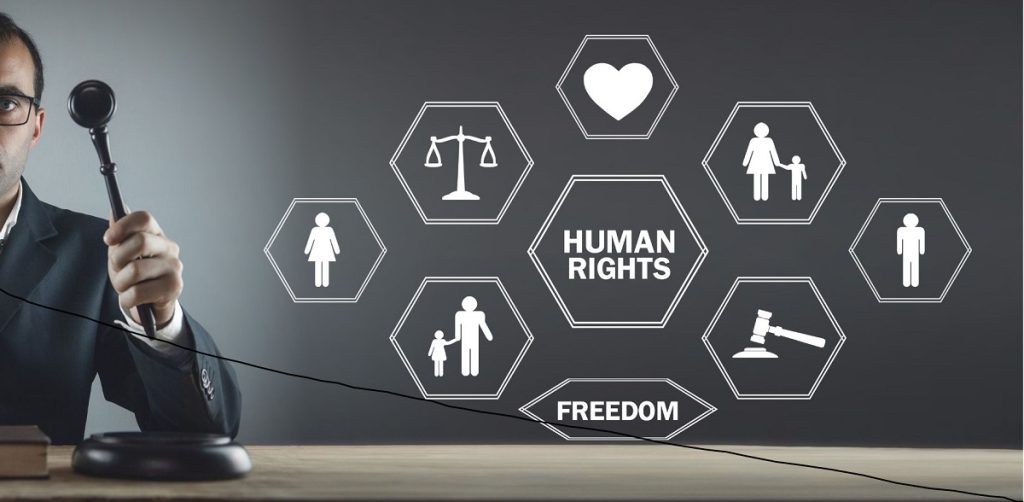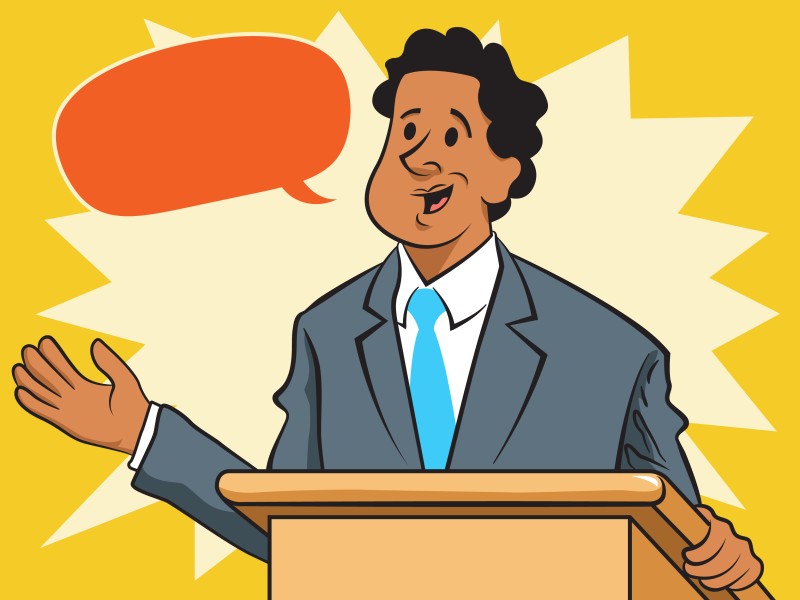
6 Key Components of a Winning Stump Speech

As a candidate for elected office you’re going to be giving plenty of speeches, so you’ll need to have your stump speech down pat.
Strong public speaking conveys confidence and leadership to voters.
It assures donors and supporters that you’re the right person for office.
Unfortunately, too many candidates are not good public speakers.
They don’t have a key message or theme.
Their words wander all over the place.
They don’t make sense and wind up confusing their audience.
I witnessed this the one night by a candidate who is running his own campaign.
He had good ideas. He had a solid resume.
His speech however did not effectively convey that he’s up for the job.
With a little fine-tuning he would be much better.
A good stump speech makes a huge difference in a candidate’s race, their fundraising, and in gathering endorsements.
That’s why I always work with my candidates on their stump speeches.
I’ve even turned the things I teach candidates into a premium course The Secrets of a Winning Stump Speech .
Most of my clients have never ran for office before.
They’re not used to public speaking, even in front of small groups.
Over the course of my career, I’ve noticed that there are six key components that make for a good stump speech.
If you follow these, you’ll be in good shape as a candidate and might even surprise yourself as a public speaker.
1. Who You Are and What You’re Running For
Never assume that the voters know who you are.
They likely don’t.
Your mission as a candidate for office is to build your name recognition and support for your candidacy.
Even if you’ve been introduced by someone, always begin your stump speech by telling your audience who you are and the office your running for.
If you’re married, say so and tell them how long you’ve been married.
If you have children, list your kids and how old they are, and what kind of things they’re into.
Should your spouse, children, parents, or other family members be present, be sure to point them out by name and thank them for their support for your campaign — especially if it’s your spouse.
It’s a cardinal sin in the political world to not introduce or thank your spouse.
2. Where You Come From
Voters like to elect real people from real places with real lives.
After you introduce yourself and the office you’re running for, tell them where you grew up, a little about your family life, and how that impacted your life.
If you’re running in a community where you’ve lived all of your life, or most of it, make sure that’s highlighted in your stump speech.
Mention the schools you went to, where you played sports, your first job in town, your favorite place to eat, or that your parents still live there.
This creates an instant connection with the voters and will make it easier for them to become supporters.
3. What You’ve Dones
Experience matters to voters.
They want to know that you’ve accomplished something in your life.
In your stump speech, tell them about where you graduated from college (if you did), your military service (if you served), the jobs you’ve had (if you’ve never had a job or a business — why are you even running?)
Voters want to know these things for two reasons:
1) it shows you can set goals and accomplish them
2) it demonstrates you’re not afraid of hard work
This is especially true in today’s political environment when the perception of elected officials is that they’re only in office to cash for themselves and their family members, rather than work hard and accomplish something for their constituents.
Have you noticed that critics of both Joe Biden and Donald Trump each use this line of attack?
Talk about your professional experience — the things you’ve done and learned that have prepared you for office.
If you volunteer or are active in community organizations, put this in your stump speech.
But please be careful not to come off as bragging.
That will turn off voters rather than endear them to you.
Yes, Donald Trump violates this admonition often, and it reflects negatively his approval ratings and poll numbers.
If Trump who can get away with so much that other candidates cannot is still damaged by this, don’t think you’ll fare any better.
4. What You Want to Accomplish
Voters like candidates who have a plan.
They want to know why you’re running for office and what you intend to do once you’re elected.
The best way to clarify this is by understanding what your campaign is about in one sentence, as detailed in this article.
When giving your stump speech, incorporate your One Sentence into your remarks and build upon it.
It’s best to have three specific things you want to accomplish.
Your goals should align with three problems that need to be fixed.
Hopefully you’ve done some polling or other type of opinion research so you’ll know what issues and problems are foremost on your voters’ minds.
State each problem, describe how you’d like things to be better, and outline the steps you believe that can be taken to get there.
While you need to show that your plan is realistic, be careful not to get into too many specifics with your solutions to these problems.
While you need to know the specifics for when you are elected, and when people ask you for details, giving specifics and details in your stump speech will bore your audience.
Bored voters don’t convert into supporters.
Excited voters do, plus they tell their friends to vote for you.
5. It’s Not About I, It’s About We
One of the biggest pitfalls candidates for elected office can face is making it all about themselves.
While you may be the one running, elections are not about candidates.
They are about voters.
Elections are where the voters get to have their say on people and policy.
If you make it about you, you’ll fall into the “I, me, mine” trap, become labeled as a “politician” and turn off the voters you need.
When giving your stump speech always change the word “I” to the word “we” when it’s possible.
Clearly, when talking about where you grew up, went to school, work, and your family, you’re going to use “I.”
But when you are talking about what you want to do in office, things that you’ve been a part of in your community, or accomplishments you were involved in as part of a larger organization, use the word “we.”
Speaking to your audience with the word “we” creates a bond and buy-in with your ideas. That’s the effect that you’re after with your stump speech.
In 2016, Hillary Clinton severely violated this rule.
She had supporters say, “I’m with her.”
It didn’t work because she was asking the voters to focus on her as the candidate — rather than focusing on the voters and the shared mission they were on together.
Donald Trump spun that around masterfully and told his supporters “I’m with you.”
6. Close Strong
Closing your stump speech the right way is important.
After you’ve listed what you want to do in office, tell the audience that you can’t do this without their help.
Weaving “we” throughout your stump speech ties this in nicely for your finish.
If you’re talking to voters, ask them for their votes.
If you’re talking to donors, ask them for their contributions.
If you’re talking to leaders of an organization that endorses, ask them for their support.
There’s no reason for anyone to give you what you want unless you specifically ask for it.
As one professor I had always said, “If you don’t ask, you don’t get.”
Make the ask then it’s time for you to go.
End by thanking your audience for their time.
Always do this. Tell them you appreciate taking the time to listen to you.
Grateful candidates tend to be winning candidates.
Candidate Take-Aways
If you follow these six rules you’ll be able to craft an effective stump speech.
Go figure yours out and write it out word for word.
After you write it out, go and learn it.
Learn it and practice your stump speech, but don’t memorize it.
You don’t want to come off like a robot.
If it helps, write an outline of our speech and refer to that when you’re speaking.
The first speech you give will likely be difficult and you may hate doing it.
That’s fine.
Keep giving your stump speech.
You’ll get better at it each time you speak.
Before you know it you won’t need an outline to refer to, you won’t be nervous, and people will be coming up to you when you’re finished telling you what a great speaker you are.
Now if you’d like to go deeper and learn exactly how to write, rehearse, and deliver a solid stump speech, t ap this link for instant access to the premium course Secrets of a Winning Stump Speech.

Copyright 2015 - 2023, Brian Floyd Enterprises, Inc. Design & Developed by Themagnifico
NOV 3, 2016 AT 2:15 PM
The Perfect Presidential Stump Speech
We asked former republican speechwriter barton swaim and democratic speechwriter jeffrey nussbaum to write a totally pandering bipartisan stump speech for an imaginary presidential candidate — one who espouses only positions that a majority of voters agree with. here’s the speech they wrote, including notes to explain their phrasing, behind-the-scenes tips on appealing to voters and the data they used to decide which positions to take..
By Barton Swaim and Jeff Nussbaum
Research by Harry Enten , Christianna Silva and David Nield , graphics by Ella Koeze , production by Gus Wezerek
Illustration by Bewilder.tv
RELATED STORIES
Comments add comment .
- Privacy and Terms of Service

Political Campaign And Stump Speech Examples Reveal The Candidate

Candidates for political office make stump or campaign speeches to help voters learn about themselves and their positions throughout the campaign. Here are some examples of political campaign and stump speeches.
In the dynamic world of politics, one powerful tool remains a constant in winning over voters’ hearts and minds: the stump speech. This iconic oratory tradition has shaped countless political campaigns, delivering a potent blend of charisma, policy promises, and persuasive rhetoric.
From fiery appeals for change to heartfelt tales of personal struggles, stump speeches have become the backbone of political communication.
This article explores compelling examples of stump speeches throughout history, unveiling their enduring impact on electoral campaigns and their crucial role in shaping the political landscape.
Table of Contents
What Is A Stump Speech In A Political Campaign?
A stump speech is a standard, rehearsed speech a political candidate delivers during their campaign. It typically outlines the candidate’s core message, policy positions, and personal background, aiming to connect with voters, inspire support, and differentiate themselves from opponents.
A stump speech is essentially an elevator speech where the candidate makes a pitch to constituents.


How Does A Stump Speech Vary From A Campaign Speech?
While a campaign speech is a broader, more comprehensive address covering various topics and contexts, a stump speech is specifically tailored to connect with local audiences during campaign stops.
A stump speech focuses on key themes, repeated consistently across different locations, with an emphasis on connecting personally with voters, conveying authenticity, and generating enthusiasm for the candidate’s platform.
What Should A Politician Say About Themselves?
Politicians should highlight their relevant qualifications, experience, and achievements when speaking about themselves , demonstrating their ability to address the issues. They should also convey their personal values, integrity, and dedication to public service, establishing trust and credibility with the electorate.
How Do You Start Off A Campaign Speech?
“Ladies and gentlemen, distinguished guests, and fellow citizens, I stand before you today with a deep sense of gratitude and determination to embark on a journey together toward a brighter future for our community.
“Thank you all for gathering here today as we embark on a transformative campaign to shape a better tomorrow for our beloved community. With your support and collective efforts, we can build an inclusive, prosperous future filled with opportunities for all.”
What Should You Say In A Campaign Speech?
In a campaign speech, it is crucial to articulate your vision, share specific policy proposals, and address the concerns and aspirations of your constituents. Highlight your experience, values, and dedication to serve while emphasizing the need for unity, progress, and collaborative solutions to tackle the challenges our community faces.
Here is an excerpt:
“In this campaign, we must address the pressing issues affecting our constituents daily, such as education, healthcare, and economic stability, while fostering unity and collaboration to create a stronger, more resilient community for generations to come.
Together, we can bring about meaningful change, empower our citizens, and build a brighter future that reflects the hopes and dreams of each and every one of us.”

How Long Should A Campaign Speech Be?
A campaign speech should be concise and focused, aiming for around 5 to 10 minutes, allowing you to effectively communicate your message while maintaining the audience’s attention and engagement. Remember, it is crucial to prioritize quality content over excessive length to make a lasting impact on your listeners.
What Should You Do After Finishing A Stump Speech?
After delivering a stump speech, engaging with the audience is essential, and you must also show genuine interest in their concerns and feedback. Take the opportunity to connect with individuals, answer questions, and build relationships to establish trust and support for your campaign.
What Should Be Said In The Conclusion Of A Stump Speech?
In the conclusion of a stump speech, it is crucial to summarize your main points and reiterate your core message, leaving a lasting impression on your audience. You can also end the address by inspiring and rallying your supporters, calling them to action, and emphasizing how important their involvement is to the campaign.
Different ways to end a stump speech can include:
- Call to action: Encourage your audience to get involved, vote, volunteer, or contribute to your campaign, emphasizing the collective power of their actions.
- A personal story or anecdote: Share a heartfelt story your audience can connect with on an emotional level, reinforcing your commitment to their concerns and aspirations.
- Inspiring quote: Close your speech with a memorable and inspiring quote that encapsulates your campaign’s values or captures the essence of your message.
- Vision for the future: Paint a vivid picture of the future you envision for your community, highlighting the positive impact your campaign can make and leaving your audience hopeful and motivated.
The best way to end a campaign speech ultimately depends on your personal style, the context, and the specific objectives of your campaign. Consider what resonates most with your audience and aligns with your campaign’s tone and goals.
Stump Speech Examples That Define Candidates

These nine stump speeches are notable for their ability to connect with audiences, convey a powerful message, and leave a lasting impact on listeners:
- Barack Obama’s 2008 “Yes We Can” speech as presidential candidate became iconic, inspiring hope and calling for change. Ex-President Obama’s message of unity and progress resonated with millions of Americans.
- Martin Luther King Jr.’s history 1963 “I Have a Dream” speech during the March on Washington advocated for racial equality and justice for African Americans. His powerful words continue to inspire generations.
- Delivered during World War II, Winston Churchill’s “We Shall Fight on the Beaches” speech rallied the British people and affirmed their determination to resist Nazi aggression, symbolizing their resolve and resilience.
- Elizabeth Warren’s speeches on income inequality and economic fairness, such as her 2012 speech at the Democratic National Convention , have gained attention for advocating for a more equitable society.
- One of Donald Trump’s most notable stump speeches was the one delivered at the Republican National Convention in July 2016, where he formally accepted the party’s nomination for running for president. This speech emphasized his platform on immigration, national security, and job creation while highlighting his outsider status and promising to “Make America Great Again.” It resonated with many of his supporters and helped solidify his message during the campaign.
- One of Joe Biden’s most memorable speeches was his address in Pittsburgh, Pennsylvania, in August 2020. In this speech, Biden presented his economic recovery plan, emphasizing the need for unity, addressing systemic racism, and rebuilding the economy in the wake of the COVID-19 pandemic. He focused on his vision for “ Build Back Better” and stressed the importance of creating jobs, supporting working families, and tackling the climate crisis.
- A notable Hillary Clinton speech was her address at the Democratic National Convention in July 2016. In this speech, Clinton accepted the Democratic Party’s nomination for president and focused on themes of unity, inclusivity, and progress. She discussed her policy proposals, highlighted her experience and qualifications, and called for the American people “to come together to address the challenges facing the nation.”
- Ronald Reagan’s “A Time for Choosing” speech is often regarded as one of the most impactful political speeches in American history and played a significant role in shaping his political career and eventually leading to his own presidency in 1981. Reagan delivered this speech supporting Barry Goldwater’s presidential campaign on October 27, 1964, just days before the U.S. presidential election.
- Abraham Lincoln’s most famous stump speech was his Cooper Union Address, delivered on February 27, 1860, in New York City. The speech primarily focused on the issue of slavery and its expansion, but Lincoln also touched upon foreign policy concerns. In the Cooper Union Address, Lincoln argued against the spread of slavery into new territories, emphasizing its moral and constitutional implications.
Adam Howarth
Adam covers the topic of Public Speaking for Digital Authority. From his first experience of oratory with his school debating society to his more recent experiences of promoting the local business scene in Wrexham, Wales, he has always been involved in public speaking.
Recent Posts
Active Listening Absorbs The Whole Message, Not Just The Words
Active listening goes beyond hearing the words someone is saying to you and understanding the message they are conveying. Many only hear a small percentage of what is being said as they are...
Counteracting Fear Of Public Speaking With Coaching And Therapy
Nearly 75% of people experience the social phobia of fear of public speaking. The result may be nervousness before speaking or a full-blown panic attack. Practicing public speaking may lessen the...
Stump Speech

Oct 07, 2024
Political Communication Strategy: The Role of Effective Speechwriting
by Enrique Rivas (He/Him)
An essential component of a good political communication strategy is the integration of effective speechwriting. Even if your campaign doesn’t plan to deliver a ton of speeches, it’s crucial to have a structured process in place for crafting and refining them.
If you’re running for office even at the local level, chances are you’ll want to have a speech prepared at least for Election Night. If the thought of writing a speech seems intimidating, don’t panic–you can follow a simple and straightforward method to create impactful speeches.

Jan 02, 2020
Stump Speech: The Ultimate Speechwriting Guide
by Martín Diego Garcia (He/Him)
Here is our ultimate guide to writing a great stump speech. We all know that the candidate is the campaign’s best asset, and the stump speech is the best campaign tool for delivering a 7C’s (clear, concise, contrastive, connective, creative, compelling, consistent) message and personal story about the candidate and campaign.

Aug 19, 2019
Speechwriting: 7 Questions with Eric Schnure
by Elena Veatch
Eric Schnure is a former speechwriter for Vice President Al Gore who has been a freelance writer and communications consultant for over 20 years. Eric has spent his career helping elected officials, business and nonprofit executives, and entertainers hone their public speaking. He is known for incorporating humor into his speechwriting which led him to cofound the Humor Cabinet, a communications consulting firm.

Jul 17, 2017
Write a Political Speech
by The Campaign Workshop
